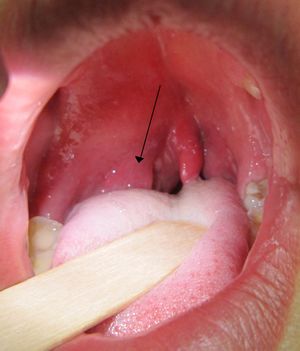We need you! Join our contributor community and become a WikEM editor through our open and transparent promotion process.
Peritonsillar abscess
From WikEM
(Redirected from Peritonsillar Abscess (PTA))
Contents
Background
- Abbreviation: PTA
- Abscess between tonsillar capsule and superior constrictor and palatopharyngeus muscles
- Microbiology
- Polymicrobial: strep/staph, anaerobes, eikenella, haemophilus influenzae
Clinical Features
Symptoms
- Fever
- Sore throat
- Odynophagia/dysphagia
Signs
- Trismus
- Muffled voice ("hot potato voice")
- Contralateral deflection of swollen uvula
Differential Diagnosis
Acute Sore Throat
Bacterial infections
- Streptococcal pharyngitis (Strep Throat)
- Neisseria gonorrhoeae
- Diphtheria (C. diptheriae)
- Bacterial Tracheitis
Viral infections
- Infectious mononucleosis (EBV)
- Patients with peritonsillar abscess have a 20% incidence of mononucleosis [1]
- Laryngitis
- Acute Bronchitis
- Rhinovirus
- Coronavirus
- Adenovirus
- Herpesvirus
- Influenza virus
- Coxsackievirus
- HIV (Acute Retroviral Syndrome)
Noninfectious
- Stevens-Johnson Syndrome
- Pemphigus
- Angioedema
Other
- Deep neck space infection
- Peritonsillar Abscess (PTA)
- Epiglottitis
- Kawasaki disease
- Penetrating injury
- Caustic ingestion
- Lemierre's syndrome
- Peritonsillar cellulitis
- Lymphoma
- Internal carotid artery aneurysm
- Oral Thrush
- Parotitis
- Post-tonsillectomy hemorrhage
Evaluation
- Ultrasound
- Differentiates cellulitis from abscess
- Can use an intraoral approach using a endocavitary probe or transcutaenous approach using a linear probe
- Can identify depth of neck vasculature prior to aspiration
- CT with IV contrast
- Differentiates PTA from parapharyngeal or retropharyngeal space infection
Management
Drainage
- The recurrence rate after aspiration is 10% and the cure rate is 93% to 95%. Recurrence rate for aspiration alone may be higher than I&D [2][3]
- May need IV pain meds, sedation or procedural sedation
- Glycopyrrolate can reduce secretions
Needle Aspiration
- Apply anesthetic spray to overlying mucosa
- Have patient hold suction and use as needed
- Use laryngoscope or disassembled vaginal speculum with wand as tongue depressor and light source
- Inject 1-2mL of lidocaine with epinephrine into mucosa of anterior tonsillar pillar using 25 gauge needle
- Cut distal tip off of needle sheath and place over 18ga needle to expose 1 cm of needle to prevent accidentally plunging deeper than desired
- Aspirate using 18 gauge needle just lateral to the tonsil
- Use static ultrasound to determine depth of vasculature.
- Though always a concern, carotid injury has not been clearly documented as a complications[4]
- May require multiple aspirations to find the abscess
- First try superior then middle then inferior poles
- Consider spinal needle if patient has significant trismus
I&D
- #11 or #15 blade scalpel
- Do not penetrate more than 1cm
- Only advance posteriorly
- May be indicated if significant pus with needle aspiration
Antibiotics
Coverage for Streptococcus species, anerobes, Eikenella, H. influenza, S. auresus
Outpatient Options
- Clindamycin 300mg PO Q6hrs x7-10d
- Amoxicillin/Clavulanate 875 mg PO BID x 7-10d
- Penicillin V 500mg PO + Metronidazole 500mg QID
Inpatient Options
- Ampicillin/Sulbactam 3 gm (75mg/kg) IV four times daily
- Pipericillin/Tazobactam 4.5 gm IV TID
- Ticarcillin/Clavulanate 3.1 g IV QID
- Clindamycin 600-900mg IV TID
- Penicillin G 4 million units (50,000 units/kg) IV four times daily + Metronidazole 500mg IV three times daily
Steroids
Decreases duration and severity of pain
- Methylprednisolone 125mg IV x1 OR dexamethasone 10mg PO/IM x1
Disposition
- Generally may be discharged with ENT follow-up
- If no pus can be obtained but there is high suspicion for a PTA, admit with IV antibiotics (30% neg aspiration still have PTA)
- In pediatric patients 50% respond to med management[5]
Return Precautions
- shortness of breath
- Worsening throat or neck pain
- Enlarging mass
- Bleeding
- Neck stiffness
Prognosis
Complications
- Airway obstruction
- Rupture abscess with aspiration of contents
- Hemorrhage due to erosion of carotid sheath
- Retropharyngeal abscess
- Mediastinitis
- Recurrence occurs in 10-15% of patients
- Lemierre's syndrome
- Iatrogenic laceration of carotid artery
- Carotid artery is 2.5 cm behind and lateral to tonsil
Indications for tonsillectomy
- Airway obstruction
- Recurrent severe pharyngitis or PTA
- Failure of abscess resolution with drainage
See Also
References
- ↑ Melio, Frantz, and Laurel Berge. “Upper Respiratory Tract Infection.” In Rosen’s Emergency Medicine., 8th ed. Vol. 1, n.d.
- ↑ Johnson RF, Stewart MG. The contemporary approach to diagnosis and man- agement of peritonsillar abscess. Curr Opin Otolaryngol Head Neck Surg. 2005;13:157
- ↑ Wolf M. Peritonsillar abscess: repeated needle aspiration versus incision and drainage. Ann Otol Rhinol Laryngol. 1994 Jul;103(7):554-7.
- ↑ Herzon FS, Martin AD. Medical and surgical treatment of peritonsillar, retropharyngeal, and parapharyngeal abscesses. Curr Infect Dis Rep. 2006;8(3):196.
- ↑ Blotter JW, Yin L, Glynn M, et al. Otolaryngology consultation for peritonsillar abscess in the pediatric population. Laryngoscope. 2000;110(10 Patient 1):1698.

